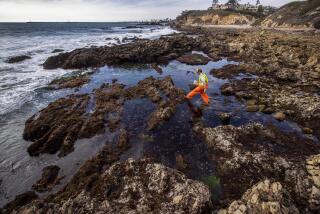What if an oil spill happened at an Arctic well?
- Share via
Reporting from Seattle and Washington — A coalition of some of the nation’s most influential environmental groups launched an 11th-hour challenge Wednesday to halt the next frontier in offshore drilling — the July start of Shell Offshore Inc.’s plan to drill three exploration wells in the Arctic.
The groups —the Sierra Club, the Wilderness Society and the Natural Resources Defense Council — appealed to U.S. Interior Secretary Ken Salazar to suspend the drilling plan at least until a cause can be determined for the disastrous blowout in the Gulf of Mexico.
They warned that the challenges of coping with an oil rig blowout in remote Arctic waters “would far surpass those related to BP’s Deepwater Horizon explosion,” which is estimated to be gushing oil into the gulf at a rate of 5,000 barrels a day. They said Shell’s emergency plans are weak and there is a lack of sufficient support crews and emergency equipment to respond quickly to a significant oil spill.
Shell Offshore Inc. has long planned to drill three exploration wells this summer up to 72 miles offshore in the Beaufort and Chukchi seas, a region of turbulent waters, heavy fog and shifting ice hundreds of miles from deep-water ports. The nearest Coast Guard base is nearly 1,000 miles away. Shell paid $2.1 billion for its Chukchi lease in 2008.
After years of litigation, Shell has secured the majority of it drilling permits, but Interior officials have stressed that the operation is still subject to review. Salazar on Wednesday called the Deepwater Horizon accident in the Gulf “a lesson that we need to learn from.”
Curtis Smith, external affairs manager for Shell Alaska, said the company plans “to continue mobilizing in hopes of drilling this summer. We would not do so unless we were absolutely confident in our ability to operate safely and responsibly in the Alaska OCS”—the outer continental shelf—”an area in which we have significant experience and an excellent track record.”
The George W. Bush administration had proposed vastly expanding Arctic oil and gas drilling and had issued some leases, including the Shell plan now under scrutiny. But President Obama canceled most of Bush’s oil drilling plans and did not include new Arctic drilling in his own offshore proposals announced in March.
Before the gulf disaster, the Obama administration had said the Shell exploratory drilling would be allowed to proceed to “help develop critical information about this frontier area.”
Moving into the offshore Arctic, believed to hold the world’s largest untapped gas reserves, is a critical component of several successive administrations’ determination to lower America’s dependence on foreign energy supplies.
Though Shell drilled a limited number of exploration wells in the region in the 1980s and 1990s, the new leasing program is expected to launch the first wide-ranging move into Arctic waters, which U.S. officials believe could hold 27 billion barrels of oil and 132 trillion cubic feet of natural gas.
Unlike the Gulf of Mexico, where offshore drilling is easily accessible to the massive oil industry infrastructure along the coast, the Arctic is a remote region where cleanup crews may be hampered by bone-chilling cold, 24-hour-a-day darkness, 20-foot waves, clouds too low to launch aircraft and waters too shallow to bring in large ships.
To drill there, Shell must assemble a small flotilla of oil spill response equipment that will accompany the drilling rig, backed up by teams and equipment stationed 240 miles away at Prudhoe Bay and elsewhere along the North Slope.
“Based on my experience, the likelihood of being able to contain and clean up and control a well blowout in the Arctic is slim,” said Leslie Pearson, who managed the state of Alaska’s oil spill program for six years and who now consults on oil spill issues.
“A lot of that is just the location, the lack of infrastructure in that part of Alaska, where the equipment would have to come from to actually get on scene and be mobilized and operational.…There really aren’t even any ports up in that part of the world.”
So concerned is the federal National Oceanic and Atmospheric Administration that it advised the federal Minerals Management Service last year to hold off on further oil and gas development off the Alaska coast until more research is done on oil spill risks. Obama heeded those warnings when developing his drilling plan.
“The challenges posed by Arctic conditions are greatly understated” in the existing federal documents preparing for leasing on the Arctic shelf, NOAA said.
Shell says a blowout of the kind that occurred at the Deepwater Horizon rig would be highly unlikely in Alaska, in part because the Arctic operations would be occurring in shallower water — 150 feet instead of 5,000 feet — and at far lower well pressure.
“The barriers and contingencies we have in place and the significantly different characteristics of the wells we plan to drill here gives us tremendous confidence that the chances of a similar event taking place in the Alaska offshore is extremely remote,” said Curtis, the Shell spokesman.
In the “extremely unlikely” event of a blowout or spill, Shell would be ready to respond in one hour with an “unprecedented” three-tier system consisting of an on-site oil spill response fleet, near-shore barges and additional vessels and response teams staged across the North Slope, company officials said.
The company is required to be able to handle a blowout of 5,500 barrels per day, about the size of the Gulf of Mexico release.
The Minerals Management Service estimates there is a 40% chance of a major oil spill of 1,000 gallons or more once drilling commences in the Chukchi Sea. But, as happened with the Deepwater Horizon lease, the agency calculated that the chances of a full blowout were so minuscule that it elected not to do a full study of what the environmental consequences of such a disaster would be.
Company officials said they have also conducted multiple independent inspections of the blowout preventer, a device whose apparent failure may have led to the Deepwater Horizon accident, to assure it could not experience a similar failure.
The exploration program is scheduled to take place in the relatively ice-free summer months, but oil spills under icy conditions raise a new level of complexity: how to track and control oil trapped under ice, how to gather oil that is seeping through melting ice, how to move vessels and containment booms through closely clustered ice floes.
Cleanup under these conditions could take months, some scientists studying the problem predict, in a harsh, fragile environment where rejuvenation milestones may be measured in decades, not years.
“If a spill were to happen off the coast of the North Slope, maybe 500 miles or so in broken or light ice conditions, it could realistically be days or weeks before anyone could even get to the source of the spill,” said Joe Cunningham, research engineer with the NOAA-funded Coastal Response Research Center in New Hampshire.
“The other problem is since the Arctic is such a new environment for oil spill operations, we’re kind of relying on equipment that was developed for warm water use. There hasn’t been a lot of study done on how that same equipment will operate under Arctic conditions.”
Recent industry-backed studies in Norway have suggested that low Arctic temperatures could actually help in spill cleanups. “Ice is a blessing and a curse,” said Ron Morris, general manager of Clean Alaska Seas, an industry co-op that handles spill cleanup on the North Slope. “It’s hard to get around in it, but it also doesn’t allow the oil to expand; it keeps it kind of like a boom, captured, and it keeps the oil layer thicker.”
Times staff writer Christi Parsons in Washington contributed to this report.
More to Read
Sign up for Essential California
The most important California stories and recommendations in your inbox every morning.
You may occasionally receive promotional content from the Los Angeles Times.










